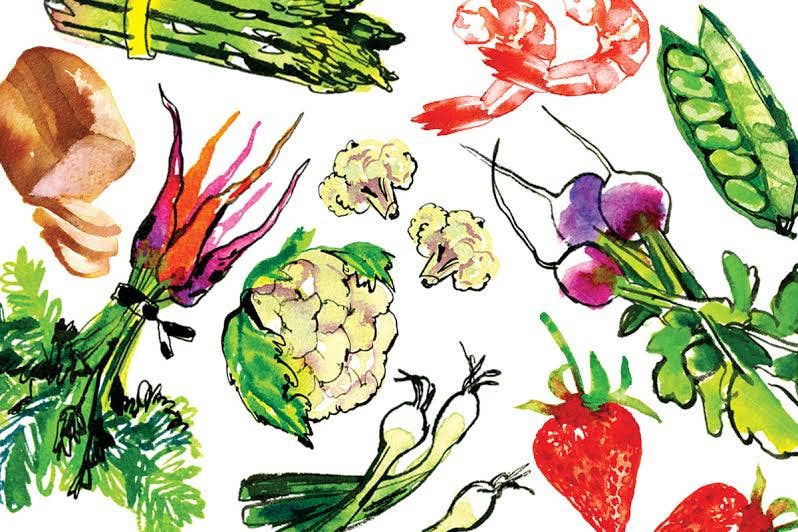
Cast-Iron Man
My mother couldn't cook. The pancakes at our house were always black around the edges, the vegetables were always canned or frozen (and usually corn or squishy peas), and I was 16 before I knew that meat wasn't gray inside. But I did inherit from her one great culinary legacy—not a book of recipes or a technique for making piecrust or an innate love for oysters or for broccoletti, but a set of three Wagner brand cast-iron skillets, six and a half, eight, and ten inches in diameter.
These are the real thing, well over half a century old, darkest black, seasoned and reseasoned countless times, slightly crusty on the bottom, and stranger by now to almost no ingredient or culinary technique. And if they have been mistreated over the years, as they undoubtedly have (by both myself and my mother, who mostly used them for scorching Spam or bacon), this only seems to have lent them character; they wear their blemishes proudly, like battle scars, and haven't faltered once because of them.
Cast-iron skillets are great cooking vessels. They are relatively slow to heat up (compared with copper or aluminum), but they do so evenly, and stay hot for a long time. They feel good in the hand, and don't skitter around on slanting burners like those nonstick pans that behave like they're made of metal-coated balsa wood. They stand up to very high temperatures, travel easily from stove top to oven (and work perfectly well in fireplaces and on barbecue grills, too—all this assuming, of course, that they aren't the kind with wooden handles), and deglaze beautifully. They are also, I might add, exactly the pan you'd want to have around if, God forbid, you should ever need to bonk a burglar on the head.
Cast-iron skillets are also definitively American cooking vessels. Iron itself was probably invented by the Chinese around 1100 b.c., and had inched its way to Europe by around the 14th century. In both places, it was cast into pots and kettles (as well as weapons of war, agricultural implements, and such), but the traditional process of casting iron, which means melting iron ore and then pouring it into molds to harden, was arduous and time-consuming. American ironmongers in the mid-1800s streamlined the process, learning how to liquefy the ore at higher temperatures for smoother pouring, and developing sturdier molds. According to cast-iron cookware collector and historian Joel Schiff, skillets (commonly called griddles until the 1850s, and still known today in parts of New England as spiders) made of this material grew in popularity in America along with the development of the individual home stove. The numerals on many old skillets correspond to the size of the cooking holes (i.e., the burners) on old cast-iron stoves. A no. 8 skillet, for instance, would fit over a no. 8 hole; try to use it on a no. 9 hole, and it would fall right in.
Modern-day cast-iron skillets are made in much the same way as they have been for 200 years. As Lodge Manufacturing Company of South Pittsburg, Tennessee, today the largest manufacturer of cast-iron cookware in the country, explains in its brochure (and I paraphrase): A pattern is made—the reverse image of a skillet, with a runner system that allows the molten metal to flow in. Sand is then squeezed under very high pressure into the pattern to form the mold. Molten iron (at 2,800°F) is poured in. After the metal cools and solidifies into the skillet shape, it is removed from the sand (which is recycled). Remaining sand particles are blasted off the skillet with abrasive steel shot, then rough edges are ground smooth. A stone-wash bath deburrs or dulls any sharp edges left over, then the skillet is dipped in nontoxic food-grade wax as a protective coating.
If you weren't lucky enough to inherit old cast-iron skillets (though your mother was, I'm sure, a better cook than mine), I recommend looking for them in thrift shops and at garage sales. And if you buy a new one, the folks at Lodge recommend that, after seasoning it (see Seasoning Cast Iron), you cook bacon or fry chicken—something good and greasy—in it the first five or six times you use it.
Bacon and chicken are, in fact, two of the best things to make in cast iron. But I find my skillets so in-tensely pleasurable to use—they feel solid and authoritative, and somehow grounded in both history and culinary lore—that I end up doing almost everything with them: crisping hash and hashlike combinations of leftovers (see Making a Hash of It); searing meat, fish, or fowl; stir-frying; deep-frying; baking (cornbread, biscuits, nut breads, etc.); making casseroles; melting cheese; toasting nuts and spices—even cooking asparagus or other vegetables in water, which most cast-iron types would consider sacrilege. I also put all kinds of acidic things, like wine and lemon juice and tomatoes, in them—''nonreactive'' be damned. (They've got 50-plus years of seasoning, after all.) And I wash them with water (though rarely soap) and scrub them lightly with a soft brush, instead of swabbing them out with an old rag like some folks do. Hey, it works, and they're my pans—and I haven't burned the pancakes yet.
Keep Reading
Continue to Next Story










